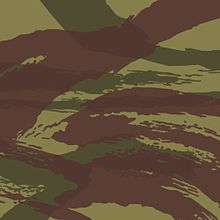Lizard (camouflage)
| Lizard pattern | |
|---|---|
 French Lizard pattern fabric. | |
| Type | Military camouflage pattern |
| Place of origin | France |
| Service history | |
| In service | 1947-1980s (French service) |
| Used by | See Users |
| Wars |
Vietnam War Syrian Civil War |
| Production history | |
| Designer | Numerous |
| Manufacturer | Numerous |
| Produced | 1947-1980 (French production only) |
The lizard pattern (TAP47 pattern or Leopard pattern for the French) is a family of many related designs of military camouflage pattern, first used by the French Army on uniforms from 1947 to the late 1980s. It was based on the British paratroopers' Denison smock.[1][2]
There are two major types of lizard pattern, horizontal like the original French design, and vertical like the early variant developed by Portugal. In addition, the Vietnam War tigerstripe pattern is descended from Lizard.[1]
Evolution of lizard patterns

Lizard patterns have two overlapping prints, generally green and brown, printed with gaps so that a third dyed color, such as a lighter green or khaki, makes up a large part of the pattern. In this, it is printed like earlier British patterns used on that country's Paratroopers Denison smocks. Lizard patterns have narrower printed areas than the British patterns, and the original form had a strong horizontal orientation, disrupting the vertical form of the soldier's body.[1]
Horizontal lizard patterns
Horizontal lizard patterns in different colour forms were made by the French. A copy of the French pattern, made in Asia, was adopted by some African countries such as Chad, Gabon, Rwanda, and Sudan. In around 1970 Cuba designed a gray variety, used by Cuba and by the FAPLA of Angola. Greece has used a range of horizontal lizard patterns from the 1970s. Russian Spetsnaz and interior ministry troops wear horizontal lizard patterns.[1] The Israel Defence Force used actual French lizard uniforms (donated by France) until 1968, alongside plain (unpatterned) battledress.[3] French lizard was among the patterns used in Congo in 1978.[4]
Vertical lizard patterns
Vertical lizard patterns in different colorways were apparently developed in Portugal from the original French horizontal patterns. The lizard pattern had been in use in Portugal since 1956 with the Air Force's Paratroopers, being extended to the Army's Special Rifles units in 1960. With the Portuguese Military engaged in the Overseas Wars mainly fought in the African jungles, the camouflaged uniform was issued throughout the whole Army and some units of the Navy and Air Force. In 1963, a vertical lizard pattern was developed, this replacing the French horizontal pattern. Paradoxically, the Portuguese vertical lizard pattern become popular amongst some of the guerrillas that opposed Portugal in the Overseas Wars and was latter adopted by the armed forces of some of the former Portuguese African colonies after their independence.[5] The Portuguese vertical lizard pattern was adopted by Brazil, which developed a range of colorways for each of its armed services. Egypt, Greece, India, Lebanese Palestinians and Syria have all used variants of the vertical lizard pattern.[1] SWAPO guerrillas in Namibia wore a wide variety of camouflage, including Portuguese lizard. [6]
Other descendants
The Vietnam War tigerstripe is descended from Lizard. It began as a French experimental pattern during the Indochina war. It was based on the TAP47 lizard pattern, and was adopted by the South Vietnamese Marines. Tigerstripe differed from lizard in having its printed areas interlocked rather than overlapped; it also used smaller areas of dyed background color.[1]
Users
Current
Former






.svg.png)
Non-State Actors
References
- 1 2 3 4 5 6 "Lizard". Camopedia. Retrieved 25 March 2016.
- ↑ "Epochs Field Guide to Camouflage: Lizard". Epochs. Retrieved 25 March 2016.
- 1 2 Katz, Sam; Katz, Samuel M. (23 June 1988). Israeli Elite Units Since 1948. Osprey Publishing. pp. 54–55. ISBN 978-0-85045-837-4.
- ↑ Abbott, Peter; Ruggeri, Raffaele (2014). Modern African Wars (4): The Congo 1960-2002. Osprey Publishing. p. 46. ISBN 978-1-78200-078-5.
- ↑ "smock, camouflage (Portuguese, 'Lizard 'Pattern)". Imperial War Museum. Retrieved 25 March 2016.
- ↑ Wolverton, Martin (20 December 2012). Bush Wars: Africa 1960–2010. Bloomsbury Publishing. p. 134. ISBN 978-1-84908-770-4.
- ↑ https://www.middleeastmilitaria.com/bahrain-special-forces-lizard-camo-uniform.html
- ↑ https://www.sadefensejournal.com/wp/?p=3713
- 1 2 3 https://www.ammoland.com/2009/08/eotac-brings-back-lizard-pattern-camo/#axzz5On2aHssE
- 1 2 Camouflage at War: An Illustrated Guide from 1914 to the Present Day by Martin J. Dougherty, p. 66
- ↑ Israeli Soldier vs Syrian Soldier: Golan Heights 1967–73 by David Campbell, Page 20.
- 1 2 3 Bush Wars: Africa 1960–2010 by Ambush Alley Games, p. 134.
- ↑ https://epochs.co/features/epochs-field-guide-to-camouflage
- ↑ Spetsnaz: Russia’s Special Forces by Mark Galeotti, page 16.
| Wikimedia Commons has media related to Lizard camouflage. |
.jpg)